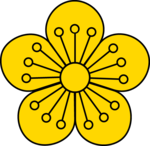Yi dynasty
 
|
|
| Country |
|
|---|---|
| Titles | |
| Founded | 17 July 1392 - Joseon's founding. |
| Founder | Taejo of Joseon |
| Final ruler | Sunjong of Korea |
| Current head | Yi Hae-won and Yi Won |
| Deposition | 1910 - Japan–Korea Treaty of 1910 |
| Ethnicity | Korean |
| Cadet branches |
125 cadet branches (approximately 105 extant) including:
|
125 cadet branches (approximately 105 extant) including:
The House of Yi, also called the Yi Dynasty, Korean Imperial Household or Jeonju Yi clan, was the household of Joseon and the Korean Empire, consisting of the descendants of Yi Seonggye, the founder of Joseon, known by his posthumous name, Taejo ("highest ancestor"). All his descendants are members of the Jeonju Yi clan, including the imperial family of the Korean Empire (1897–1910).
After the Japan–Korea Treaty of 1910, in which the Empire of Japan annexed the Korean Peninsula, some members of the Yi clan were mediatised into the Imperial House of Japan and the Japanese peerage by the Japanese government until 1947, just before the Constitution of Japan was promulgated. Since then, their status as royalty has not been acknowledged by any country; however, they continue to attract occasional media attention in South Korea. This happened most recently with the July 2005 funeral of Yi Gu, former head of the royal household.
At present, three members claim themselves as heirs to the throne. Yi Won, a first cousin and the son of the 9th son of Prince Ui, has posthumously adopted as son of Gu by the house members' decision, thus regarded as de facto head of the house. Yi Hae-won, his aunt and second eldest daughter of Prince Ui, was declared as the empress by some of the house members at 2006. Yi Seok, another son of Prince Ui, leads independent imperial restorationist organization and recognized as an heir. Another member has claimed to have visited the United States, and have attended college in Irvine, California.
In the 19th century tensions mounted between China and Japan, culminating in the First Sino-Japanese War. Much of this war was fought on the Korean Peninsula. Japan, after the Meiji Restoration, acquired Western military technology, and forced Joseon to sign the Japan–Korea Treaty of 1876. Japan encroached upon Korean territory in search of fish, iron ore, and natural resources. It also established a strong economic presence on the peninsula, heralding the beginning of Japanese imperial expansion in East Asia.
...
Wikipedia
